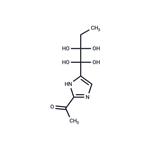THI (94944-70-4) was identified as a biologically active impurity in caramel food coloring.1 It is a potent inhibitor of sphingosine-1-phosphate (S1P) lyase.2 It disrupts lymphocyte egress from lymphoid tissue by interfering with S1P gradients.3,4 The novel immunomodulatory activity of THI and its biochemical mechanism may represent a new target for the development of new generation of immunosuppressants.5
2-Acetyl-4-(1,2,3,4-tetrahydroxybutyl)imidazole used for treatment of autoimmune disorders.
Sphingosine-1-phosphate (S1P) lyase catalyzes the irreversible decomposition of S1P to hexadecanaldehyde and phosphoethanolamine. 2-Acetyl-5-tetrahydroxybutyl imidazole (THI) is an inhibitor of S1P lyase. Because S1P lyase is primarily expressed in lymphatic tissue, treatment of mice with THI (50 μg/ml in drinking water) increases lymphoid tissue S1P concentrations 100-fold, reducing lymphocyte egress from thymus and peripheral lymphoid organs. The resulting lymphopenia is reversible following cessation of THI treatment. Reducing S1P lyase activity results in therapeutic levels of immunosuppression without the non-lymphoid lesions that result from synthetic S1P receptor agonists.
2-Acetyl-5-tetrahydroxybutyl imidazole (THI) can block S1P lyase in vivo and up-regulates circulatory and tissue S1P levels. It has the ability to repress dystrophic muscle degeneration.
1) MacKenzie et al. (1992), Toxicity Studies of Caramel Colour III and 2-Acetyl-4(5)-Tetrahydroxybutylimidazole in F344 rats; Food Chem. Toxicol. 30 417
2) Ohtoyo et al. (2015), Sphingosine 1-phosphate lyase inhibition by 2-acetyl-4-(tetrahydroxybutyl)imidazole (THI) under conditions of vitamin B6 deficiency; Mol.Cell Biochem. 400 125
3) Gugasyan et al. (1998), Emigration of mature T cells from the thymus is inhibited by the imidazole-based compound 2-acetyl-4-tetrahydroxybutylimidazole; Immunology 93 398
4) Schwab et al. (2005), Lymphocyte sequestration through S1P lyase inhibition and disruption of S1P gradients; Science 309 1735
5) Bradbury et al. (1997), The immunomodulatory compound 2-acetyl-4-tetrahydroxybutyl imidazole causes sequestration of lymphocytes in non-lymphoid tissue; Immunol. Cell Biol. 75 497
![1-[4-(1,2,3,4-TETRAHYDROXYBUTYL)-1H-IMIDAZOL-2-YL]ETHANONE Structure](/CAS/GIF/94944-70-4.gif)
